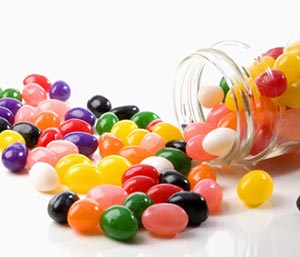Food additives help our food last longer and can make it taste, look and smell like something it is not. They enable food to sit on supermarket shelves and then in our cupboards for months – and sometimes years – without going bad. Finally, we eat them. In fact it has been estimated that we consume close to 5kg of food additives as preservatives, colours, flavours, emulsifiers, stabilisers and bleaches each year. In Australia there are more than 400 additives currently approved for use. This means that we are likely to be consuming a cocktail of chemicals, the cumulative effect of which is unknown.
As well as placing a burden on our bodies detoxification mechanisms which must attempt to rid these chemicals from our bodies, food additives are associated with asthma attacks, hayfever, sinusitis, rashes, hives, migraines, hyperactivity, irritability, insomnia, diarrhea, colicky pains and more.
Food additives are listed on the label, along with other ingredients, in a descending order by weight. The additive will sometimes be spelt out in full. At other times, it is represented by a number, for example, Monosodium Glutamate (MSG) may be listed simply as 621. Some additives may cause more problems than others and it is important to scrutinise labels carefully. Some examples include: Sulphites (220-228), preservatives found in many foods including cordial, wine, processed fruit and vegetables, dried fruits, sausages and bread can trigger asthma attacks and hyperactivity; Tartrazine (102) and Sunset yellow (110), food colourings found in drinks, ice-cream and confectionary are associated with allergies, hyperactivity and aspirin sensitivity; Monosodium glutamate (621) is a flavour enhancer found in stock cubes, gravy mixes, soups, sauces, flavoured chips and snacks can cause allergies, asthma, hyperactivity, adverse reactions and aspirin sensitivity. See http://www.foodstandards.gov.au/consumer/additives/additiveoverview/Pages/default.aspx for a complete listing of food additives and their uses.
What about those worried about their weight? Aspartame (often referred to as NutraSweet or Equal)(951) is an artificial sweetener found in diet drinks, sugar free chewing gum, diabetic confectionary and ice cream. However, this chemical is associated with close to 100 health side effects including blurred vision, seizures, tinnitus, dizziness, headaches, overactive thyroid, irritability, abdominal pain, nausea, joint pain, and hyperactivity in children. These effects are due to the toxins that result from aspartame breakdown – methyl alcohol, formaldehyde, formic acid and aspartic acid. Ironically, in addition to its toxic side effects, aspartame can also cause carbohydrate cravings and consequently weight gain.
To minimise your exposure to food additives there are a number of steps you can take:
- Buy organic foods where possible
- Become a label sleuth and discard foods with more numbers than letters
- Buy fresh foods
- Make your own stocks, soup bases, sauces and gravy
- Make your own muffins and biscuits
- Drink plain filtered water and avoid flavoured milks, soft drinks, cordials and juices
- Educate yourself about brands that do not contain additives. For example, preservative free breads include those by Bakers Delight and Brumbys Bakeries, and in the supermarket – Country Life, Moores, and Mountain Bread are just a few.
- Check out the website http://www.fedupwithfoodadditives.info for great information on the best brands to buy, where to buy them, as well as the health implications of food additives

